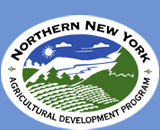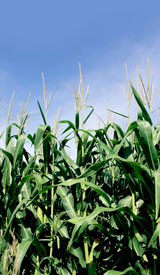August 26, 2008
Contacts: see end of release
North Country Farmers Baling -- Not Hay, but Ag Plastics
BigFoot is coming to North Country dairy farms in Clinton, Essex,
Franklin, Jefferson, Lewis, and St. Lawrence counties. BigFoot is a
baler that condenses used agricultural plastics, such as silo covers and
silage bags from dairy farms, into 40-inch-square cubes ready for
recycling.
Cornell Cooperative Extension, the Northern New York Agricultural
Development Program, New York Farm Viability Institute, and regional
Resource Conservation and Development and Soil and Water Conservation
District leaders are encouraging North Country farmers to prepare for
the baler’s arrival by learning how to handle their used plastics.
The Cornell Recycling Ag Plastics Project has begun demonstrating the
baler, which can also take greenhouse plastics and irrigation and maple
tubing, on North Country farms. Dairy farmers interested in having the
baler visit their farm or who wish to supply plastic for demonstrations
should follow suggested best management practices for collecting their
used plastics and call their local Cooperative Extension office for
baler dates and details.
Best management practices for collecting used agricultural plastics
include:
• 1) as much as possible, keep the used plastic free of mud and manure;
• 2) shake dirt and debris and pull weeds out of the plastics;
• 3) fold, roll or cut dry plastics into easily handled bundles,
• 4) separate different types of plastics, e.g., keep bale wrap separate
from bale twine, separate bale wrap from ag bags and bunker covers, ag
bags and bunker covers can be grouped together, keep feed bags separate
and store other materials in separate groups, and
• 5) store baler-ready bundles under cover to keep them clean, dry and
out of sunlight.
New York is the second state to test the current edition of BigFoot.
Dennis Sutton of Bradenton, Florida, has been engineering the plastics
baler by modifying and “beefing up” the type of equipment used for
baling tobacco. The model being used on Northern New York farms is a
trailer-mounted, gas-powered baler that is towed by truck from farm to
farm.
One baler has already been demonstrated on farms in Clinton and Franklin
counties. New York State Senator Elizabeth “Betty” Little secured
funding that allowed the Champlain Watershed Improvement Coalition and
Clinton County Soil & Water Conservation District to purchase a baler
for use in those counties. In Clinton County, farmers began storing
their plastics more than three months ahead in anticipation of the
baler’s arrival.
Northern New York Agricultural Development Program Co-Chair Joe Giroux,
Plattsburgh says, “The Northern New York agricultural industry is
pleased to have all six of our counties participating in this project.
Ag plastics recycling is one more way farmers can take an active role in
being good land and water stewards and at the same time reduce the cost
of farming.”
Cornell Cooperative Extension of Clinton County Dairy Educator Blake
Putman helped organized Big Foot’s first 2008 visit to Northern New
York. She says, “Dairy and livestock farmers from all sizes of farm
operations have become involved in this project. I take calls regularly
from producers who have heard about the baler and want to schedule a
time for the baler to visit their farms. They are excited to have a
“greener” option for ag plastics disposal.”
As part of the Recycling Ag Plastics Project, Dr. Lois C. Levitan of
Cornell University’s Environmental Risk Analysis Program is identifying
existing and potential recycling markets that will take the used dairy
plastics and is encouraging the development of local recycling
enterprises. The farm plastics can be reconstituted into such products
as plastic lumber and fence posts.
The Recycling Ag Plastics Project has major funding from the New York
Farm Viability Institute. New York Farm Viability Institute Executive
Director Thomas Sleight says, “This recycling project is facilitating
farmer interest in properly disposing of used plastics and getting them
off the farm using a coordinated, regional approach. The three pilot
areas of the project are setting a model for the rest of New York state
to follow.”
Recycling Ag Plastics Best Management Practices information is online at
http://environmentalrisk.cornell.edu. For more information for all
agricultural sectors of Northern New York, go online to
www.nnyagdev.org. # # #
CONTACTS for Recycling Ag Plastics Project
Recycling Ag Plastics Project Leaders:
• Dr. Lois C. Levitan, 607-255-4765
• Field Coordinator David Cox, 607-437-9794
Recycling Ag Plastics Project Key Regional Contacts:
• Western NNY: Chanda Lindsay, Director, Black River/St. Lawrence
Resource Conservation & Development, 315-782-7289 x129
• Eastern NNY: Steve Mahoney, Manager, Clinton County Soil & Water
Conservation District, 518-561-4616 x3; Blake Putman, Dairy Educator,
Cornell Cooperative Extension of Clinton County, 518-561-7450 x106
Cornell Cooperative Extension:
• Clinton County – Blake Putman, 518-561-7450 x106
• Essex County – Anita Deming, 518-962-4810
• Franklin County – Carl Tillinghast, Richard Gast, 518-483-7403
• Jefferson County – Art Baderman, 315-788-8450
• Lewis County – Frans Vokey, Joe Lawrence, 315-376-5270
• St. Lawrence County Brent Buchanan, 315-379-9192
Northern New York Agricultural Development Program Co-Chairs:
• Jon Greenwood, Canton, 315-386-3231
• Joe Giroux, Plattsburgh, 518-563-7523
BigFoot Baler designer: Dennis Sutton, 941-761-8293



